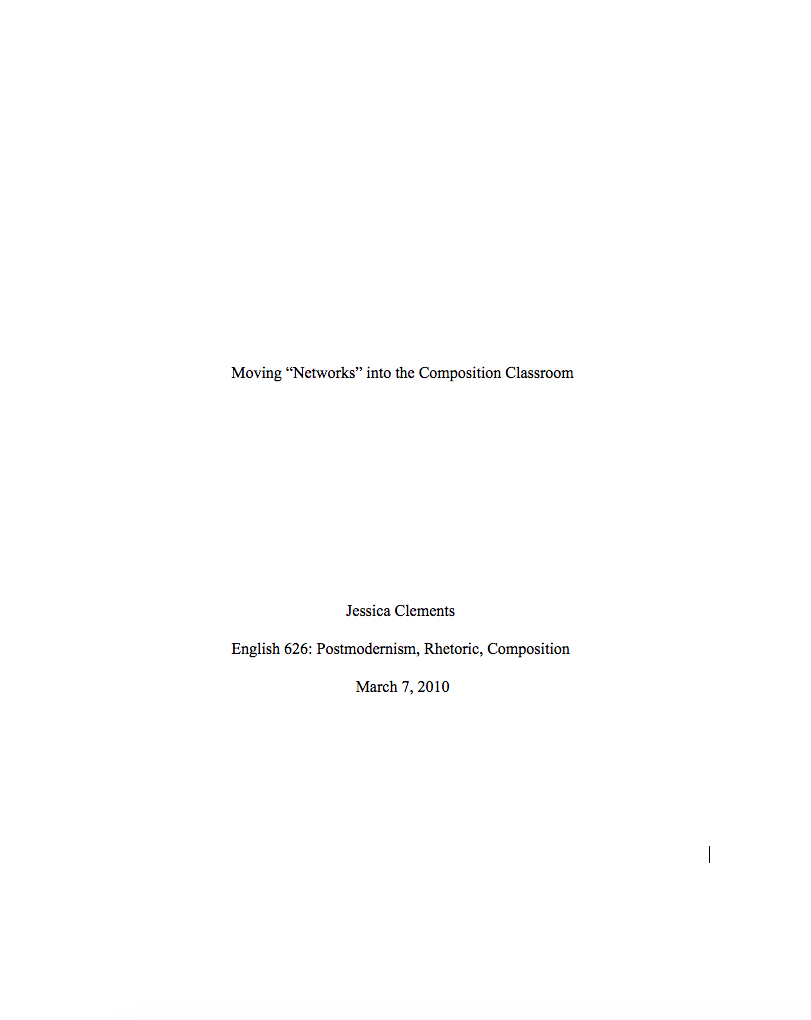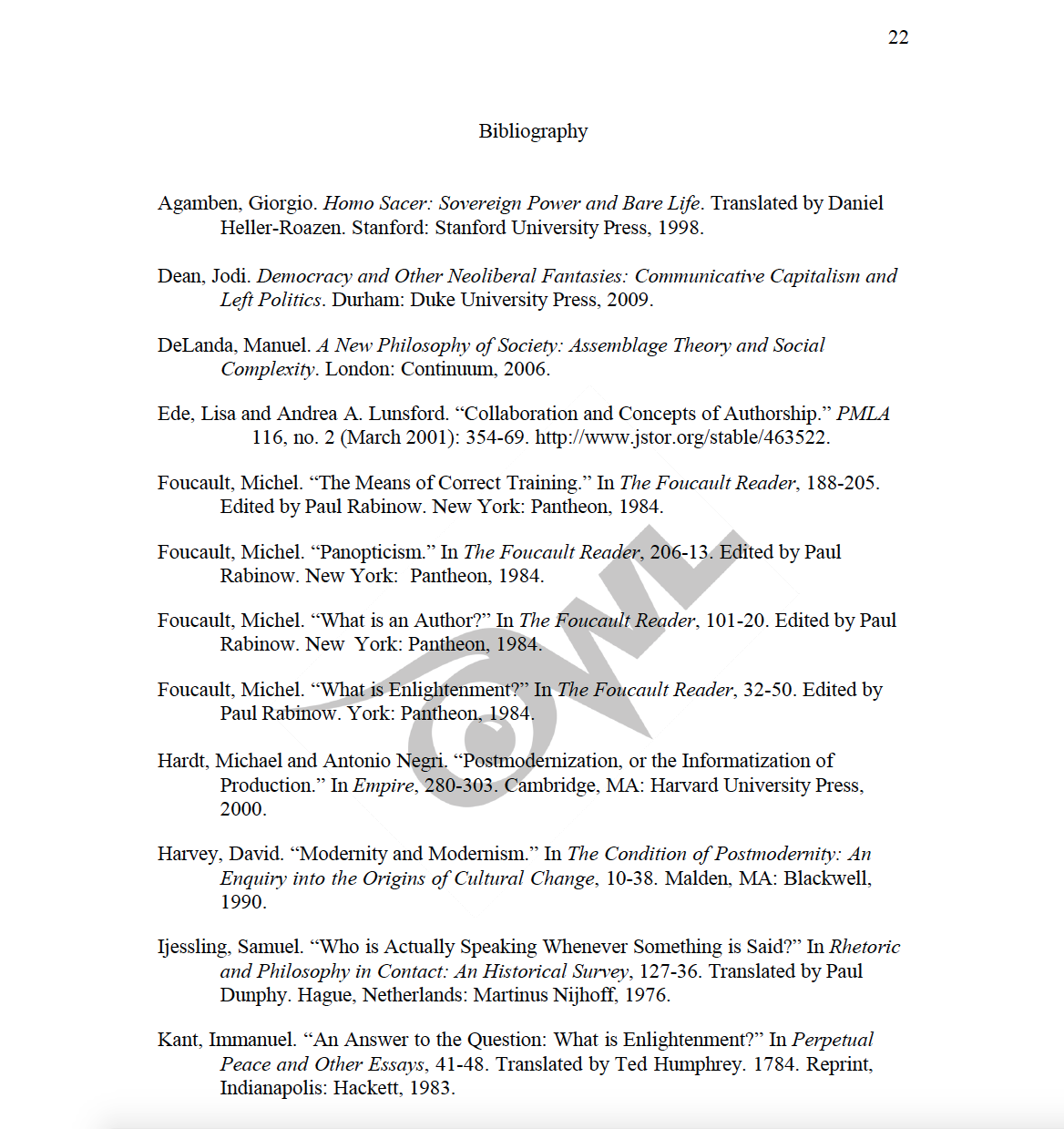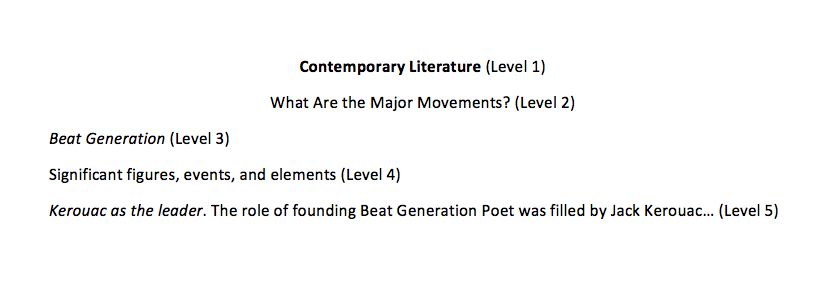General Format

Welcome to the Purdue OWL
This page is brought to you by the OWL at Purdue University. When printing this page, you must include the entire legal notice.
Copyright ©1995-2018 by The Writing Lab & The OWL at Purdue and Purdue University. All rights reserved. This material may not be published, reproduced, broadcast, rewritten, or redistributed without permission. Use of this site constitutes acceptance of our terms and conditions of fair use.
Since The Chicago Manual of Style (CMOS) is primarily intended as a style guide for published works rather than class papers, these guidelines will be supplemented with information from, Kate L. Turabian’s Manual for Writers of Research Papers, Theses, and Dissertations (8th ed.), which is largely based on CMOS with some slight alterations.
To see a side-by-side comparison of the three most widely used citation styles, including a chart of all CMOS citation guidelines, see the Citation Style Chart.
Please use the example at the bottom of this page to cite the Purdue OWL in CMOS.
A Note on Citations
Unlike many citation styles, CMOS gives writers two different methods for documenting sources: the Author-Date System and the Notes-Bibliography (NB) System. As its name suggests, Author-Date uses parenthetical citations in the text to reference the source's author's last name and the year of publication. Each parenthetical citation corresponds to an entry on a References page that concludes the document. In these regards, Author-Date is very similar to, for instance, APA style.
By contrast, NB uses numbered footnotes in the text to direct the reader to a shortened citation at the bottom of the page. This corresponds to a fuller citation on a Bibliography page that concludes the document. Though the general principles of citation are the same here, the citations themselves are formatted differently from the way they appear in Author-Date.
If you are using CMOS for school or work, don't forget to ensure that you're using your organization's preferred citation method. For examples of these two different styles in action, see our CMOS sample papers:
General CMOS Guidelines
- Text should be consistently double-spaced, except for block quotations, notes, bibliography entries, table titles, and figure captions.
- For block quotations, which are also called extracts:
- A prose quotation of five or more lines, or more than 100 words, should be blocked.
- CMOS recommends blocking two or more lines of poetry.
- A blocked quotation does not get enclosed in quotation marks.
- A blocked quotation must always begin a new line.
- Blocked quotations should be indented with the word processor’s indention tool.
- Page numbers begin in the header of the first page of text with Arabic number 1.
- Subheadings should be used for longer papers.
- CMOS recommends you devise your own format but use consistency as your guide.
- For CMOS and Turabian’s recommendations, see “Headings,” below.
- CMOS recommends you devise your own format but use consistency as your guide.
Supplemental Turabian Style Guidelines
- Margins should be set at no less than 1”.
- Typeface should be something readable, such as Times New Roman or Courier.
- Font size should be no less than 10 pt. (preferably, 12 pt.).
Major Paper Sections
Title Page
- According to Turabian style, class papers will either include a title page or include the title on the first page of the text. Use the following guidelines should your instructor or context require a title page:
- The title should be centered a third of the way down the page.
- Your name, class information, and the date should follow several lines later.
- For subtitles, end the title line with a colon and place the subtitle on the line below the title.
- Double-space each line of the title page.

CMOS Title Page
- Different practices apply for theses and dissertations (see Kate L. Turabian’s A Manual for Writers of Research Papers, Theses, ad Dissertations [8th ed.].
Main Body
- Titles mentioned in the text, notes, or bibliography are capitalized “headline-style,” meaning first words of titles and subtitles and any important words thereafter should be capitalized.
- Titles in the text as well as in notes and bibliographies are treated with quotation marks or italics based on the type of work they name.
- Book and periodical titles (titles of larger works) should be italicized.
- Article and chapter titles (titles of shorter works) should be enclosed in double quotation marks.
- The titles of most poems should be enclosed in double quotation marks, but the titles of very long poems should be italicized.
- Titles of plays should be italicized.
- Otherwise, take a minimalist approach to capitalization.
- For example, use lowercase terms to describe periods, except in the case of proper nouns (e.g., “the colonial period,” vs. “the Victorian era”).
- A prose quotation of five or more lines should be “blocked.” The block quotation should match the surrounding text, and it takes no quotation marks. To offset the block quote from surrounding text, indent the entire quotation using the word processor’s indentation tool. It is also possible to offset the block quotation by using a different or smaller font than the surrounding text.
designed into the fabric of existence itself, into the
organization of space, time, visibility, circuits of
communication. And these enwrap each individual life
decision and action—about labour [sic], purchases, debts,
credits, lifestyle, sexual contracts and the like—in a web
of incitements, rewards, current sanctions and foreboding
of future sanctions which serve to enjoin citizens to
maintain particular types of control over their conduct.
These assemblages which entail the securitization of
identity are not unified, but dispersed, not hierarchical
but rhizomatic, not totalized but connected in a web or
relays and relations. (246)
References
- Label the first page of your back matter, your comprehensive list of sources, “Bibliography” (for Notes and Bibliography style) or “References” (for Author-Date style).
- Leave two blank lines between “Bibliography” or “References” and your first entry.
- Leave one blank line between remaining entries.
- List entries in letter-by-letter alphabetical order according to the first word in each entry, be that the author's name or the title of the piece..
- Use “and,” not an ampersand, “&,” for multi-author entries.
- For two to three authors, write out all names.
- For four to ten authors, write out all names in the bibliography but only the first author’s name plus “et al.” in notes and parenthetical citations.
- When a source has no identifiable author, cite it by its title, both on the references page and in shortened form (up to four keywords from that title) in parenthetical citations throughout the text.
- Write out publishers’ names in full.
- Do not use access dates unless publication dates are unavailable.
- If you cannot ascertain the publication date of a printed work, use the abbreviation “n.d.”
- Provide DOIs instead of URLs whenever possible.
- If no DOI is available, provide a URL.
- If you cannot name a specific page number when called for, you have other options: section (sec.), equation (eq.), volume (vol.), or note (n.).

CMOS Bibliography Page
Footnotes
- Note numbers should begin with “1” and follow consecutively throughout a given paper.
- In the text:
- Note numbers are superscripted.
- Note numbers should be placed at the end of the clause or sentence to which they refer and should be placed after all punctuation, except for the dash.
- In the footnotes:
- Note numbers are full-sized, not raised, and followed by a period (superscripting note numbers in the notes themselves is also acceptable).
- Lines within a footnote should be formatted flush left. Place commentary after source documentation when a footnote contains both; separate commentary and documentation by a period.
- In parenthetical citation, separate documentation from brief commentary with a semicolon.
- Do not repeat the hundreds digit in a page range if it does not change from the beginning to the end of the range.
For more information on footnotes, please see CMOS NB Sample Paper.
Headings
While The Chicago Manual of Style does not include a prescribed system for formatting headings and subheads, it makes several recommendations.
- Maintain consistency and parallel structure in headings and subheads.
- Use headline-style for purposes of capitalization.
- Subheadings should begin on a new line.
- Subheadings can be distinguished by font-size.
- Ensure that each level of hierarchy is clear and consistent.
- Levels of subheads can be differentiated by type style, use of boldface or italics, and placement on the page, usually either centered or flush left.
- Use no more than three levels of hierarchy.
- Avoid ending subheadings with periods.
Turabian has an optional system of five heading levels.
Turabian Subheading Plan
|
Chicago Headings |
|
|
Level |
Format |
|
1 |
Centered, Boldface or Italic Type, Headline-style Capitalization |
|
2 |
Centered, Regular Type, Headline-style Capitalization |
|
3 |
Flush Left, Boldface or Italic Type, Headline-style Capitalization |
|
4 |
Flush left, roman type, sentence-style capitalization |
|
5 |
Run in at beginning of paragraph (no blank line after), boldface or italic type, sentence-style capitalization, terminal period. |
Here is an example of the five-level heading system:

CMOS Headings
Tables and Figures
- Position tables and figures as soon as possible after they are first referenced. If necessary, present them after the paragraph in which they are described.
- For figures, include a caption, or short explanation of the figure or illustration, directly after the figure number.
- Cite the source of the table and figure information with a “credit line” at the bottom of the table or figure and, if applicable, after the caption. The credit line should be distinguished from the caption by being enclosed in parenthesis or written in different type.
- Cite a source as you would for parenthetical citation, and include full information in an entry on your Bibliography or References page.
- Acknowledge reproduced or adapted sources appropriately (i.e., photo by; data adapted from; map by...).
- If a table includes data not acquired by the author of the text, include an unnumbered footnote. Introduce the note by the word Source(s) followed by a colon, then include the full source information, and end the note with a period.
How to Cite the Purdue OWL in CMOS
On the new OWL site, contributors’ names and the last edited date are no longer listed at the top of every page. This means that most citations will now begin with the title of the resource, rather than the contributors' names.
Footnote or Endnote (N):
Corresponding Bibliographical Entry (B):
“Title of Resource.” List the OWL as Publishing Organization/Web Site Name. http://Web address for OWL resource.
“General Format.” The Purdue OWL. https://owl.english.purdue.edu/owl/resource/717/02/.
Author Date In-text Citation:
("General Format" 2017).
Author Date References Page Citation:
Year of Publication. “Title of Resource.” List the OWL as Publishing Organization/Web Site Name. http://Web address for OWL resource.
2017. “General Format.” The Purdue OWL. https://owl.english.purdue.edu/owl/resource/717/02.